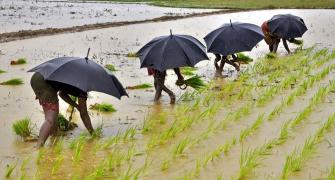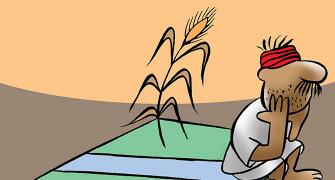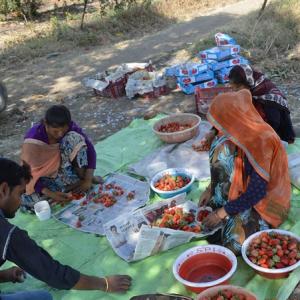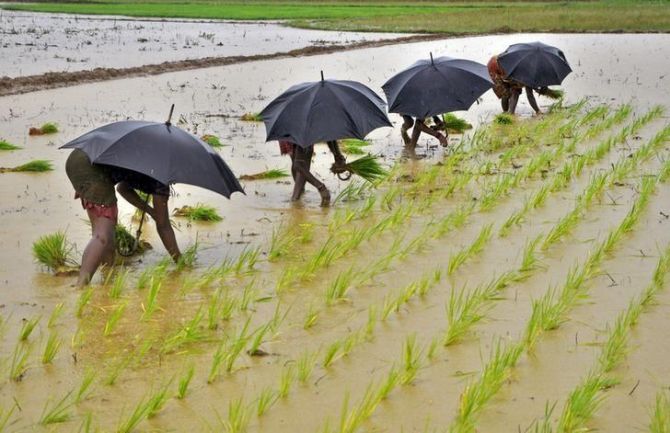The experience of direct cash transfer under PM-Kisan will be useful in designing a larger scheme of DBT for farmers combining all subsidies and support for the agriculture sector in the future, say Ramesh Chand & SK Srivastava.
Illustration: Dominic Xavier/Rediff.com

Gross value added (GVA) in agriculture increased by more than 4.5 per cent at 2011-12 prices during the recent three years including advance estimate for the year 2018-19.
This is one of the best growth witnessed in Indian agriculture.
However, this growth in GVA at constant prices did not bring same kid of cheers to farmers because of low prices of farm produce.
Farmers sell their produce at current prices, and not at constant prices, and growth in farmers’ income in real terms is affected by current prices as well as farm prices relative to prices paid by farmers.
Implicit price deflator for the agriculture sector increased by merely 1 per cent during 2017-18 and declined during 2018-19.
In contrast, implicit price deflator for the non-agriculture sector increased by 3.54 per cent and 5.45 per cent in these two years.
As a result, the terms of trade for agriculture witnessed a decline during this period of high growth in output, which implies that the growth rate in farmers’ income in real terms remained much lower than the growth rate in their output.
Similarly, WPI for food during 2018 did not witness any increase while some crops show significant fall in their wholesale prices in 2018 over 2017, creating a situation of high increase in output but a decline in income of producers of those crops.
The decline in relative prices of farm produce has led to significant dissatisfaction among farmers.
The depressed prices of farm produce and resulting low food inflation, have been beneficial for consumers but they are adverse for the producers, particularly for small and marginal farmers who are very vulnerable to price and production fluctuations and depend heavily on agricultural income for livelihood.
This created a need to provide some support to small and marginal farmers to supplement their income.
A popular response has been loan waiver or cash payment based on ownership of agricultural land like the Rythu Bandhu scheme of Telangana.
Both these initiatives have come under serious criticism. A majority of farmers still do not take loan from institutional sources and are thus not entitled to any benefit from loan waiving and those who follow discipline of repaying loan on time feel cheated.
The limitation of acreage-based payment is that 14 per cent farmers who are medium and large sized corner more than half of the support and 86 per cent of the farmers, who are small and marginal, get only 47 per cent share.
The Union government has responded to the situation by announcing the Pradhan Mantri Kisan Samman Nidhi (PM Kisan) in the Budget 2019-20.
The scheme will be implemented with effect from December 1, 2018 with the budgetary provision of Rs 20,000 crore during the current financial year and Rs 75,000 crore for the year 2019-20.
Accordingly, PM-KISAN involves direct cash transfer of Rs 2,000 in the bank account of each farmer, with up to 2 hectares of land holdings, by March 2019, plus Rs 6,000 in three equal instalments in year 2019-20.
It is pertinent to ask how much this support will matter for the small and marginal farmers and whether it will benefit tenant farmers.
The average land holding of small and marginal farmers is 0.59 hectare, of which 0.53 hectare is under cultivation.
The cost and income based on the advance estimate of GVA for the year 2018-19 can be used to assess the contribution of PM-KISAN to the small-farm economy.
The average expenditure on inputs for small farm holdings (0.53 hectare) is about Rs 13,000 while the expenditure on hired labour is about Rs 10,000.
The annual net income out of this land holding is estimated at Rs 45,000.
The assured income support of Rs 6,000 is sufficient to cover 45 per cent of the cost of inputs or 25 per cent of the cost of production including hired labour at such farms.
The income support under PM-KISAN will supplement the farm income of small and marginal holders from the crop sector by about 13 per cent.
However, there are bound to be large variations in the share of income support announced in the Budget in the average farm income across states.
The biggest advantage of this scheme over loan waiver and Rythu Bandhu is that it will also benefit tenant farmers to the same extent as the land owning farm households.
According to a nationwide NSSO survey tenants constitute 13.7 per cent of total land holdings and 80 per cent of them own some agricultural land.
Based on their own land, tenant farmers are eligible to receive cash transfer of Rs 6,000.
Only 2.6 per cent of the operational land holdings are operated by landless households, who may not be able to prove their claim for the benefit of this scheme.
Overall, PM-KISAN will cover 97.4 per cent small holders including tenants.
PM-KISAN seems quite attractive in terms of equity and coverage of farmers. In total it is estimated to cover 84 per cent of all farm households.
The experience of direct cash transfer under PM-KISAN will be useful in designing a larger scheme of DBT for farmers combining all subsidies and support for the agriculture sector in the future.
Ramesh Chand is member, NITI Aayog & S K Srivastava is agricultural economist with NITI Aayog
Views are personal










